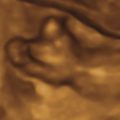Keywords
osteochondrodysplasias, skeletal dysplasias
The skeletal dysplasias or osteochondrodysplasias are a heritable group of more than 450 disorders that affect primarily bone and cartilage, but can also have significant effects on other skeletal tissues including muscle, tendons, and ligaments. By definition, skeletal dysplasias are heritable diseases that have generalized abnormalities in cartilage and bone, whereas dysostoses are genetic disorders characterized by abnormalities in a single or group of bones. Over time, the distinction between these disorders has become blurred, as the field has recognized that there is radiographic, clinical, and molecular overlap. Examples include the radial ray defects that may only grossly affect a single or group of bones, but long term may be associated with generalized growth disturbances.
Recent advances in genomic technologies have identified the molecular basis of disease in 350 of the 450 well-delineated skeletal disorders. Uncovering the molecular defects have shown that differing mutations in a single gene can produce phenotypes from mild disease—for example, early onset osteoarthritis to the lethal achondrogenesis type II.
Gene discovery provided us with the opportunity to translate research findings into clinical testing, though many of these findings have not been readily translated efficiently into the prenatal period. Determining the genes that produce these disorders will allow us to provide diagnostic services for families at risk for recurrence based on mode of inheritance and confirming diagnoses in the prenatal and postnatal period.
Embryology
The skeleton develops under two distinct processes: endochondral and membranous ossification. Endochondral ossification causes the formation of most appendicular skeletal (i.e., long) bones, and involves a sequence of orchestrated developmental processes. These include embryonic limb bud initiation from lateral plate mesoderm, specification of mesenchymal cells for the future limb elements, mesenchymal condensations triggering cartilage differentiation, ossification of developing bones, and finally, proper growth and maturation in the postnatal period. Membranous ossification is a developmental process in which condensing mesenchymal cells progress almost directly to bone cells. The bones of the skull, lateral clavicle, and pubis form via mesenchymal ossification. Postnatally, growth continues through the cartilage growth plate in which resting chondrocytes proliferate, undergo hypertrophy, and then apoptosis, becoming the growing scaffold of bone. Distinct molecular mechanisms (genes) underlie skeleton formation, and perturbations to these highly orchestrated processes can lead to skeletal dysplasias.
Genetics
The skeletal dysplasias are inherited in an autosomal recessive, autosomal dominant, X-linked recessive, X-linked dominant, and Y-linked manner. Appreciation of the mode of inheritance is critical because it imparts information regarding future recurrences. Family history is critical for initial determination of potential modes of inheritance if a fetus has findings suspicious for a skeletal dysplasia. There are some uncommonly seen patterns of inheritance in the skeletal dysplasias, including somatic mosaicism, in which one of the parents is mildly affected and their offspring is more severely affected. Evaluation of the parents should be considered if there is any question that one of the parents could have a mild skeletal disorder. Gonadal mosaicism is characterized by familial recurrence of a known dominant disorder resultant from one parent carrying heterozygosity for a mutation in one of the cell lineages in progenitor germ cells, yet the parent is clinically unaffected. This is a rare occurrence, but it influences counseling of all dominant disorders, because if a newborn is diagnosed with an autosomal dominant disorder, counseling should include a less than 1% recurrence risk based on gonadal mosaicism.
Prenatal Diagnosis of Osteochondrodysplasias
Rapid advances in both imaging modalities have markedly improved our abilities to recognize osteochondrodysplasias in the prenatal period. For those families with a parent (an autosomal dominant disorder), either molecular diagnostics via invasive techniques or ultrasound (US) imaging, or both, can aid in predicting whether the fetus will be affected. For at-risk families based on a previously affected child with an autosomal recessive disorder, the same aforementioned approach can be utilized. However, for many families, a prenatal-onset skeletal dysplasia is often the first affected individual in their respective families.
First trimester US analysis, usually used to identify aneuploidy, may also be effective in identifying severe, usually lethal, skeletal dysplasias, including osteogenesis imperfecta, thanatophoric dysplasia, and the short-rib polydactyly syndromes. If a fetus with a skeletal disorder diagnosed later in gestation was noted to have abnormal US findings in the first trimester, including a small crown-rump length for gestational age and increased nuchal fold thickness, the likelihood is that the fetus has a severe, probably lethal, skeletal dysplasia.
Many prenatal skeletal dysplasias are diagnosed in the late second trimester by US when many pregnant women are routinely screened by US for congenital anomalies. The advantage of early detection (even if an exact diagnosis is not obtained from US) is that it allows for preparation prior to delivery. This includes discussion of active resuscitation, proper assembly of consultants, collection of DNA from cord blood, and smoother transition from the prenatal to neonatal period. This is particularly critical if the neonate is predicted to have a severe but nonlethal skeletal disorder. Awareness of other potential associated morbidities, including tracheomalacia and cervical vertebral abnormalities, helps improve outcomes for these newborns.
Experience has shown that many skeletal disorders are not diagnosed in the late second trimester, particularly nonlethal, but either in the third trimester or at birth. These disorders tend to be much milder, with a less profound effect on the skeleton, and severe respiratory compromise or lethality is usually not seen. Achondroplasia, spondyloepiphyseal dysplasia congenita (SEDC), and nonlethal forms of osteogenesis imperfecta are frequently first seen in the newborn period. Many parents are then questioning if there is a suggestion of a skeletal disorder, often wondering if “something” was missed at early US. For many milder skeletal disorders, long bone measurements are frequently normal at 20 weeks, and begin to lag behind standard growth curves in the third trimester.
Stay updated, free articles. Join our Telegram channel

Full access? Get Clinical Tree







